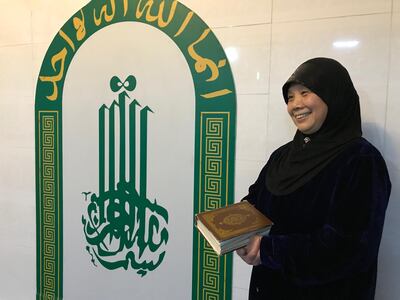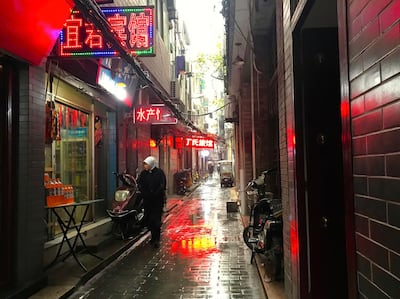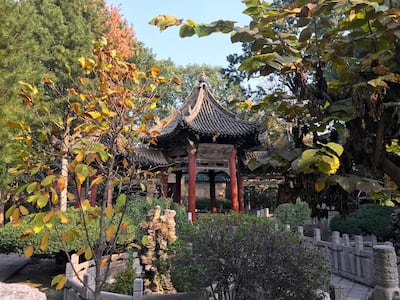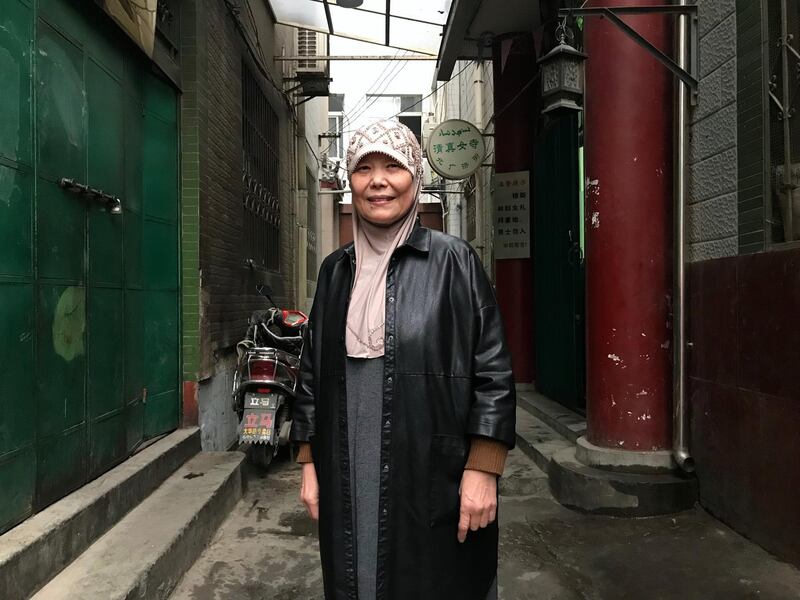Down a narrow alleyway in central Xi’an, past carts of steaming noodles and trays piled with goat hooves, is a door to a seemingly unremarkable apartment building.
Inside, is a mosque much like any other across the world but with one distinctly Chinese twist – inside this mosque, there isn’t a man in sight.
This is a nusi, a women’s mosque. It is run by women, for women. Each has a female ahong, an imam who can resolve political or social disputes, offer counsel and even lead prayers and religious ceremonies.
When women step in from the alleyway, shaking off their umbrellas and removing their coats, they have a space all their own. Here, they are led by Lee Jing Ping, who has served the congregation for a decade.
"For every mosque for men, there is a mosque for women,” she says. “This benefits the family because women play a very important role in society. A woman’s hand has always rocked the baby’s cradle and it is the same hand that rocks the cradle of social development."
China is unique for its centuries-old history of independent women’s mosques and female imams, a rare and controversial practice outside of the country.
Lee Jing Ping sits in the first-floor prayer hall, a simple space where the mihrab is painted on the wall, decorated in flowing Sini calligraphy.

She is part of a tradition unique to China’s Hui people, an ethnic group accounting for 10 million of China's Muslim population.
In the 1600s, Islam in China was in crisis. Religious knowledge was disappearing, worship was poorly practiced.
This prompted a cultural renaissance among the Hui, whose intellectuals, translators and ahong translated scripture to make it accessible.
They also realised that education had to begin in the home. At that time, women were not only unable to read Arabic and Farsi but also Chinese. For Islam to survive, they knew women had to have access to education. Before long, women themselves became educators, ensuring Islamic knowledge would be passed on through the generations.
Over time, women became formal leaders in collective celebration and managed madrasas. By the late 19th century, women’s mosques were permanent spaces and female leaders were recognised as fully fledged ahong.
Different female ahong have varying levels of power, from fairly dependent on male ahong to near autonomous. The role varies according to region, mosque and community need.
"Many women have an understanding that they have a long history of worship and pride in what they feel is a very unique gender equality within the Ummah," says Dr Maria Jaschok, the director of the International Gender Studies Centre at the University of Oxford and co-author of The History of Women's Mosques in Chinese Islam.
"The authority of female ahong is great. Women worshippers will seek out their ahong and won’t necessarily seek out a male ahong. They consider the highly educated female leaders to be quite the equal of men," Dr Jaschok says.
Lee Jing Ping does not lead prayers but guides the congregation in worship, prepares women’s bodies for burial and teaches the faithful how to pray, study literature and read the Quran in Arabic.
Prayers are broadcast from a nearby men’s mosque. It is common for women to routinely perform five daily prays at the mosque, rather than at home as is customary in much of the Islamic world. In Ramadan, the mosque's two floors fill up with worshippers.
"About 90 per cent of what I do is what a man does but some things are different,” says Lee Jing Ping. "I don’t give sermons but that doesn’t mean I don’t have work to do. I also have many responsibilities."

The Islamic quarter of Xi’an is full of women’s mosques, most of which are affiliated with a men’s mosque. Lee Jing Ping’s mosque is related to the eighth-century Great Mosque, a Tang-dynasty complex of 20 buildings set in expansive gardens of pine and juniper.
Near the entrance of the quarter, Lee Yan Fang leads a three-storey women’s mosque connected to an older men’s mosque. She quit her job as a factory worker at a packaging company 15 years ago to become its ahong.
"It’s part of my identity because I love peace and I am a servant of God," she says. "I was affected by my father, who was like an ahong, so I like everything in Islam and I’m deeply affected by it. I learnt from my father and always listened to his teachings and so became an ahong."
All religious sites in China must be registered with the government. This state control is an unexpected boon for female imams in the Hui community, granting them greater legitimacy than female Islamic leaders enjoy elsewhere in the world. In the eyes of the state, their status is equal to men.
Lee Jing Ping and Lee Yan Fang were certified 10 years ago after passing exams by the government-registered Islamic Association of China. Lee Jing Ping was the first ahong for her mosque; Lee Yang Fang took over from another. Both are paid for their work.
State control is a double-edged sword and China is no paradise for Muslim women. In China’s far west region of Xinjiang, religious restrictions on the Muslim Uighur ethnic group are severe. Uighur women do not traditionally pray in men’s mosques and can face prison for assembling in homes to worship. As many as a million Uighurs are currently held in internment camps.
The Hui community has not always practiced freely. Mosques were closed in China during the 1960s and 1970s after Mao Zedong's Cultural Revolution, which repressed all religious expression. Even today Hui Muslims can face restrictions.

Women’s mosques experienced a resurgence from the 1990s onwards, expanding in rapidly modernising China as female worshippers enjoy more economic prosperity and financial independence. They have invested in their mosques and some have become quite opulent.
But globalisation has also brought the community into greater contact with conservative interpretations of Islam from the Middle East through travel and trade. Foreign-funded mosques have more restrictive gender roles and criticise women's mosques as haram, or forbidden by Islam.
"There really is a great deal of debate within the Muslim community about whether that practice should be continued," says Dr Jaschok. "China is more open, so there are more pilgrimages and exchanges with Arab practices, and more fundamentalist and austere practices. Should this, which some people considered an aberration, something haram, be continued?
"There are voices saying: 'It’s not really known anywhere else. It shouldn’t be continued, it should be closed down.' There are quite a few vociferous voices but on the whole, women’s mosques are rising."
Ahong are unfazed.
"Firstly, I think the religion of Islam is a fair religion," says Lee Yang Fang. "So I think it’s very good and convenient for them to build a special mosque for women. Also, it’s accepted by the government so it is not haram, it’s legal."
Lee Jing Ping agrees. "I have heard women’s mosques have started in China, and other places may not have anything like this. The aim of this women’s mosque is not to struggle with each other but to study with each other."

Muslim women in Central China are making claims to equal religious authority, often using language similar to communist rhetoric on gender equality, but placed within an Islamic framework.
"You certainly find a stronger assertiveness and a greater claim to equality in terms of religious authority – the right to teach and interpret, the right to interact with the community outside mosques, the right to continue that stronger claim to equality," says Dr Jaschok.
"This claim made by the younger generation of leaders finds support from male ahong who see that as a responsibility of women, because women are able to make important and significant contributions to Islamic solidarity that is beneficial to the whole."
This has brought another cultural resurgence, the revival of jinnge chants. Farsi, Arabic and Chinese chants practiced by Hui Muslims were passed down through generations as women studied through recitation and memorisation. Jinnge chants were tremendously popular before 1949 and made a comeback after their disappearance in the mid-20th century during the Cultural Revolution.
Dr Jaschok travelled across China and recorded 600 chants for a book now used in mosques. Chants are once again performed with joy and pride before large groups of men and women.
"This is really showing off the wonderful, rich diversity of Islamic practices," says Jaschok. "It translates that into a very meaningful belief system that asserts women's place within that modern world, as believers and as modern, thinking and critical women."





